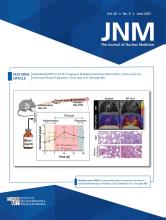Visual Abstract
Abstract
The present study was carried out to investigate whether PET imaging can be used as a potential substitute for immunohistochemical analysis of tumor samples in prostate cancer (PC) patients. Correlation between imaging signals of 2 PET tracers and the corresponding target structures was assessed. The first tracer was [68Ga]Ga-PSMA (prostate-specific membrane antigen)-HBED-CC (N,N′-bis [2-hydroxy-5-(carboxyethyl)benzyl]ethylenediamine-N,N′-diacetic acid) [68Ga]Ga-PSMAHBED-CC ([68Ga]PSMA), which is already implemented in clinical routines. The second tracer was 16β-[18F]fluoro-5α-dihydrotestosterone (16β-[18F]FDHT), which binds to the androgen receptor (AR). The AR is particularly interesting in PC, because AR expression status and its shift during therapy might directly influence patient care. Methods: This prospective, explorative clinical study included 10 newly diagnosed PC patients. Each patient underwent [68Ga]PSMA PET/MRI and [18F]FDHT PET/MRI scans before prostatectomy. Cancer SUVs were determined and related to background SUVs. After prostatectomy, tumor tissue was sampled, and AR and prostate-specific membrane antigen (PSMA) expression was determined. AR and PSMA expression was evaluated quantitatively with the open-source bioimage analysis software QuPath and with a 4-tier rating system. Correlation between imaging signals and marker expression was statistically assessed. Results: For [18F]FDHT, the SUVmax/SUVbackground ratio showed a significant, strong correlation (r = 0.72; P = 0.019) with the AR optical density of the correlating tissue sample. The correlation between PSMA optical density and the [68Ga]PSMA SUVmax/SUVbackground ratio was not significant (P = 0.061), yet a positive correlation trend could be observed (r = 0.61). SUVmax/SUVbackground ratios were higher for [68Ga]PSMA (mean ± SD, 34.9 ± 24.8) than for [18F]FDHT (4.8 ± 1.2). In line with these findings, the tumor detection rates were 90% for the [68Ga]PSMA PET scan but only 40% for the [18F]FDHT PET scan. The 4-tier rating of PSMA staining intensity yielded very homogeneous results, with values of 3+ for most subjects (90%). AR staining was rated as 1+ in 2 patients (20%), 2+ in 4 patients (40%), and 3+ in 4 patients (40%). Conclusion: [18F]FDHT PET may be useful for monitoring AR expression and alterations in AR expression during treatment of PC patients. This approach may facilitate early detection of treatment resistance and allows for adaptation of therapy to prevent cancer progression. [18F]FDHT PET is inferior to [68Ga]PSMA PET for primary PC diagnosis, but the correlation between [68Ga]PSMA SUVs and PSMA expression is weaker than that between [18F]FDHT and the AR.
- [68Ga]PSMA PET
- [18F]FDHT PET
- AR protein expression
- PSMA protein expression
- primary hormone-naïve prostate cancer
Footnotes
Published online Jan. 19, 2023.
- © 2023 by the Society of Nuclear Medicine and Molecular Imaging.








